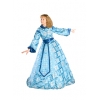|
 Crinoline is
the construction made especially to correct the shapes of a woman in compliance
with the fashion tendencies. That was fashionable some time back but not now. Today fashion is not requiring, it recommends and
advises but not requires. And in present the crinoline is the garment to see as
the detail of the wedding or evening gowns, or at the Fashion Week Shows. This
is quite uncomfortable garment to prefer for every day considering the rhythm
and speed of life which are priority today. Crinoline is
the construction made especially to correct the shapes of a woman in compliance
with the fashion tendencies. That was fashionable some time back but not now. Today fashion is not requiring, it recommends and
advises but not requires. And in present the crinoline is the garment to see as
the detail of the wedding or evening gowns, or at the Fashion Week Shows. This
is quite uncomfortable garment to prefer for every day considering the rhythm
and speed of life which are priority today.
Despite the
proved fact that the crinoline outdated for ever, fashion designers with a regular
insistence keep on launching skirts defined by the structure of crinoline. And these are notonly evening dresses.
The petticoat aka underskirt is
used as a frame with wide mini skirts and dresses with high waist line, with
long skirts which are wide and taper to the bottom and even with coat
tailoring. The collections autumn-winter 2009-2010 the crinoline was used at
fashion shows by such reputed brands as Chanel, Elie Saab, Christian Lacroix,
Valentino and many others.
Throughout
the age of life, the shape, length and width of the crinoline changed
influenced by the fashion.
The
compensating case first appeared in the late XVI century in Spain. The structure
was called vertugado and it was designed for other purposes than to emphasize
the beauty of women shapes. On the contrary, the vertugado was assigned to
conceal the shapes gifted by nature to a woman. Zoot sides of skirts were supported
with the help of metal hoops with the textile tightly stretched onto it.
It is obvious
that such an artificial shape dictated first by the strict Catholicism
practiced in Spain
would not survive for long. The Netherlands,
with its tendency to simplicity and nature renders a considerable affect onto
the European fashion in the first half of the XVII century. The skirts
supported by the metal hoops gave the floor to plain dresses of simple
tailoring.
Nevertheless,
the time of nature trends come to the end so soon and to the end of the XVII century
the skirts again come as fixed and frozen. The French high society subject to
the tendencies adopted in Spain
introduces metal case again. Therewith, vertugado is made from wood or whalebone.
Such a simplified model is called pannier in France,
fischbine in Germany and farthingale
in Russia.
The period of
the XVIII century is transitional between baroque and rococo styles
which
introduce new and fresh Oriental tendencies. Soft and tender, flowing
down fabric is in. The qualities of the fabric determines the style
of wear and the skirt attached to the metal hoop sinks in oblivion for
ever.
And this is forever, this time.
The
following periods are known for the favor for antique fashion, late rococo and
Empire style with trendy dresses with high waist line followed by the
romanticism. A slim waist is in again coming along with the girdle and a wide
skirt. Plain underskirts are not enough to ensure the appropriate fashionable
fluffiness and in 1850 the special steel or waterbone wide hoops are sewed into
the skirt and the crinoline is revived again!
Crinolines change
and modify and in the soonest time we see the variety of kinds of them. They
come puffy for evening wear and simple for every day wear, crinolines on
suspenders for dresses with high waistline, crinolines with the lacing on the
back which become the farthingale in the end.
By the end of
the XIX century a wide skirts with even sides and edges outdate and the
crinoline loses the popularity. The skirts with ruffles on the back are in with
flounces and tails, along with the bustle, the pads put under the skirt from
the back.
However, in
spite of log epoch of crinoline, it is the simplest, easiest and effective way
to make a skirt wider to the desirable extent and emphasize the waistline. And it
is always in for this reason as well as vertugado farthingale or a bustle to be
widely used in fashion to our days.
The
gorgeous structures of crinoline are appropriate for the wedding event only and
the accurate and tiny one to support the cocktail dress will be the great tool
to look attractive and feminine in most events.
|